Home / What is Mutarotation?
Carbohydrates
What is Mutarotation?
Last updated: September 19th, 2022 |
All About Mutarotation
- The OH group on C-1 of sugars can have two possible configurations. This gives rise to two stereoisomers (called “anomers”) : the “α-” anomer and the “β-” anomer.
- If you take pure “α” or pure “β” and measure their optical rotation in water, an interesting thing happens. The optical rotation slowly changes over time!
- The term “mutarotation” (literally “change in rotation”) refers to the observed change in the optical rotation of the α- and β- anomers of glucose upon dissolution in solvent. Due to ring-chain tautomerism, the α- and β- forms slowly interconvert until equilibrium is established.
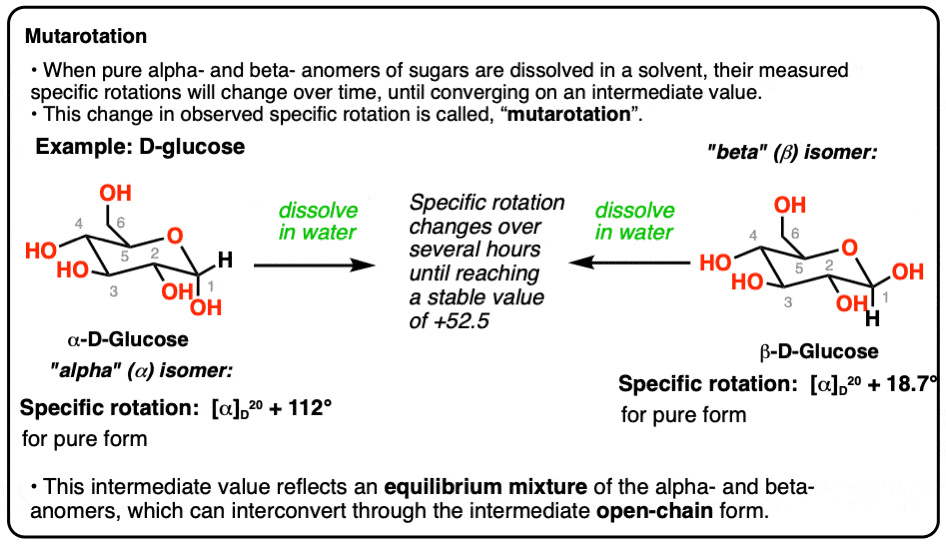
Table of Contents
- Mutarotation Is The Change In Optical Rotation Observed When Pure α- Or β- Anomers Are Dissolved In Water (or other solvents)
- Mutarotation Is Possible When α- Or β- Anomers Can Interconvert
- Mutarotation Is A Consequence Of Ring-Chain Tautomerism
- Mutarotation Is A General Property Of Cyclic Sugars Bearing A Hemiacetal
- Notes
- (Advanced) References and Further Reading
1. Mutarotation Is The Change In Optical Rotation Observed When Pure α- or β- Anomers Are Dissolved In Water (or other solvents)
In the previous article on ring-chain tautomerism, we saw that there are two isomers of D-glucose in its 6-membered ring (“pyranose”) form.
These two diastereomers – which, to make matters more confusing, are called “anomers” in the context of sugar chemistry – differ in the orientation of the hydroxyl group on C-1. (Note that C-1 is a hemiacetal. )
- In the “alpha” (α) anomer, the OH group on C-1 is on the opposite side of the ring as the chain on C-5.
- In the “beta” (β) anomer, the OH group on C-1 is on the same side of the ring as the C-5 substituent.
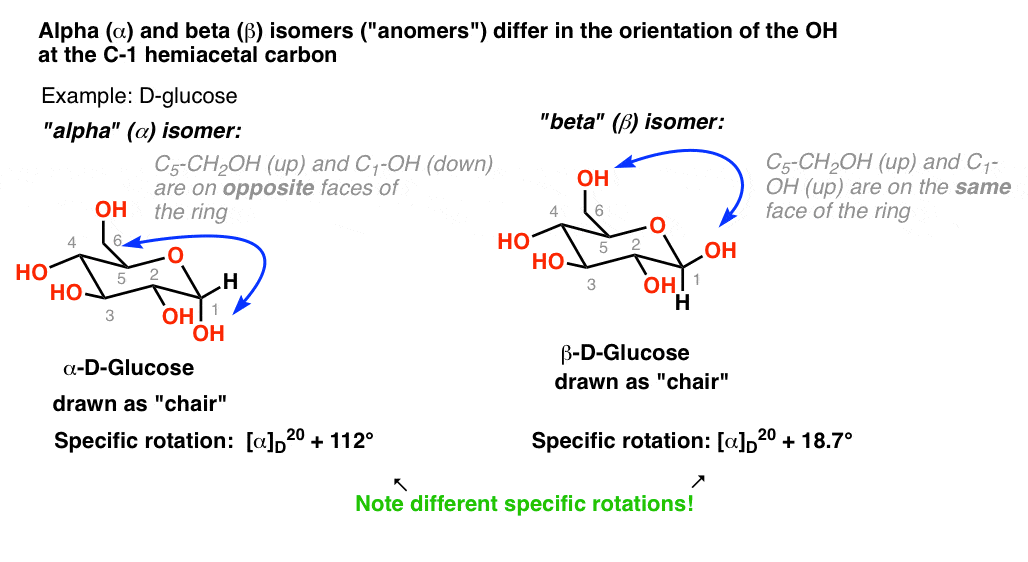
Each of these two forms can be synthesized and isolated as pure compounds.
- The alpha (α) anomer of D-glucose has a specific rotation of +112 degrees in water.
- The beta (β) anomer of D-glucose has a specific rotation of +19 degrees. (18.7 actually, but rounding up to 19).
Here’s the interesting thing. When either anomer is dissolved in water, the value of the specific rotation changes over time, eventually reaching the same value of +52.5°.
- The specific rotation of α-D-glucopyranose decreases from +112° to +52.5°.
- The specific rotation of β-D-glucopyranose increases from +19° to +52.5°.
This behaviour is called mutarotation (literally, “change in rotation”).
2. Mutarotation Is Possible When α- and β- Anomers Can Interconvert
Hold on. Isn’t specific rotation of a molecule supposed to remain the same?
Yes – if it is indeed the same molecule!
And therein lies the answer to the puzzle. For when the solutions whose specific rotations have changed to +52.5° are analyzed, they are found to no longer consist of 100% alpha (α) or 100% beta (β) anomers, but instead a ratio of alpha (α) (36%) and beta (β) (64% ) isomers.
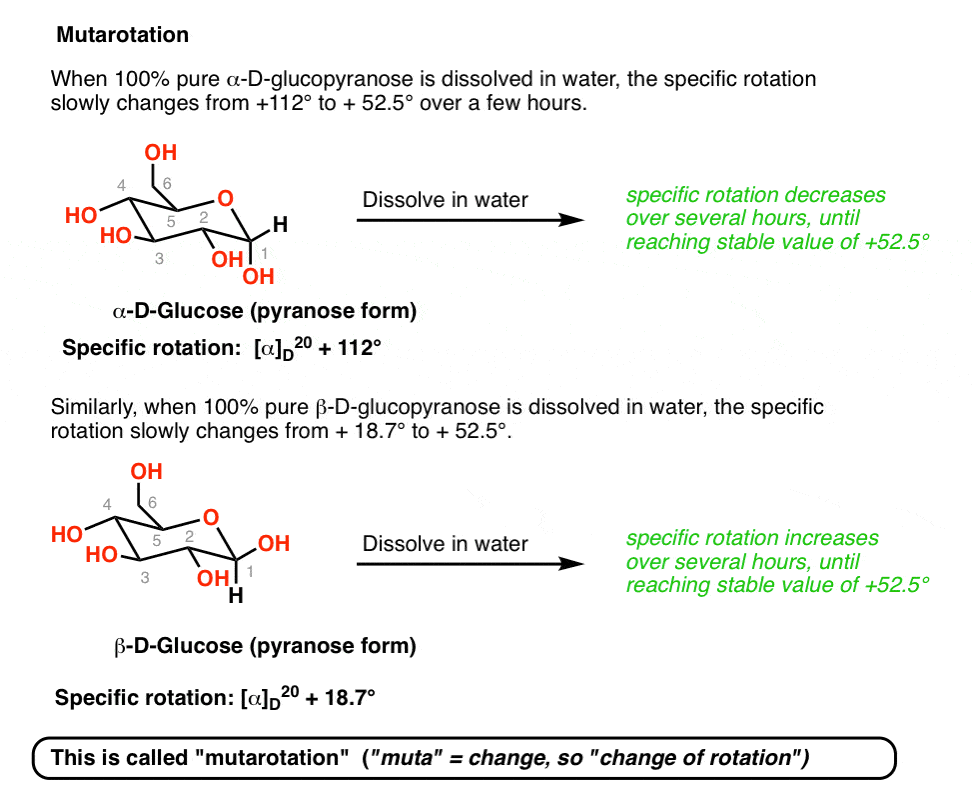
Wait. What happened here? How did the alpha convert to the beta, and vice-versa?
3. Mutarotation Is A Consequence Of Ring-Chain Tautomerism
You may recall how we said in the last post on ring-chain tautomerism that the cyclic hemiacetal forms of sugars are in equilibrium with the straight-chain (“linear”) form.
That means that even if you start with a 100% pure sample of either the alpha or beta anomer, once it has been dissolved in water it can equilibrate, via the straight-chain form, to the other anomer.
If A is in equilibrium with B, and B is in equilibrium with C, then A is in equilibrium with C. That’s the Zeroth Law of Thermodynamics [Note 1].
The 36:64 ratio of alpha (α) to beta (β) represents the distribution of isomers when D-glucose is in equilibrium in water at 25° C.
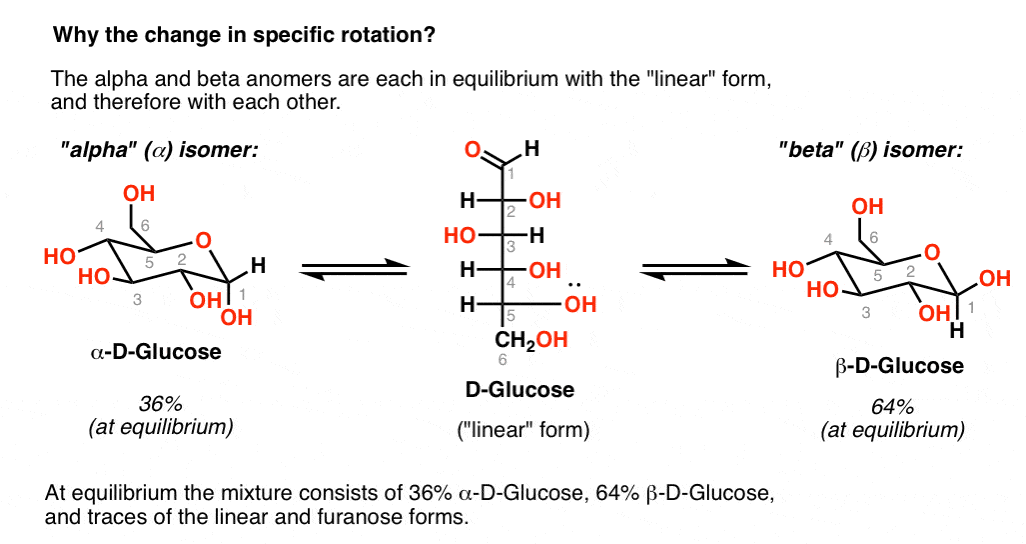
Is mutarotation unique to glucose?
4. Mutarotation Is A General Property Of Cyclic Sugars Bearing A Hemiacetal
No – it’s a general property of sugars, as well as (chiral) cyclic hemiacetals in general.
This phenomenon was first discovered in 1846 by French chemist Augustin-Pierre Dubrunfaut, who founded a factory for the production of alcohol from beet sugar. While studying the optical rotation of glucose, he noted that freshly dissolved glucose had a rotational value twice that which was previously observed in the literature. He also studied the mutarotation of lactose. (Interestingly, although Dubrunfaut was also the discoverer of fructose, he published no studies on its mutarotation – perhaps because fructose is one of the most rapidly mutarotating sugars) [Ref]
Interestingly, the structures of glucose and fructose had not been established at this point. It was not until 1895 that Tanret first reported on the two anomers of glucose, which readily explained Dubrunfaut’s observations.
Bonus question: given that the mechanism for the forward reaction was given in the previous post, can you draw a mechanism for the interconversion of alpha-D-glucose to beta-D-glucose? [A not uncommon exam question, by the way! [Note 2]
In the next post, we’ll discuss a tangent to ring-chain tautomerism: reducing sugars.
Next Post: Reducing Sugars
Thanks for reading!
Notes
Related Articles
Note 1. The Zeroth Law Of Thermodynamics: If A is in equilibrium with B, and B is in equilibrium with C, then A is in equilibrium with C.
Note 2. Try and work out a mechanism for the conversion of alpha-glucopyranose to beta-glucopyranose on your own. I’ll put a link to one solution in the comments. Hover here for a pop-up image. or click on this link.
(Advanced) References and Further Reading
This is a very classical part of organic chemistry. The change in optical activity of glucose solutions was first noted by Dubrunfant in 1846, and it was only in 1890 that the legendary chemist Prof. Emil Fischer proposed that this was due to a chemical cause. In 1896, Tanret isolated what he thought were three forms of glucose: the α form, with [α]D +105°, the β form, with [α]D +52.5°, and the γ form, with [α]D +22°. Now we know that the α and γ forms are distinct species (what we now know as the the α and β forms of D-glucose), and that Tanret’s β form is the equilibrium mixture of the two forms.
- —Studies of dynamic isomerism. I. The mutarotation of glucose
T. Martin Lowry, D.Sc.
J. Chem. Soc. Trans. 1903, 83, 1314-1323
DOI: 10.1039/CT9038301314
This paper is credited with introducing the term ‘mutarotation’ in the literature to describe the interconversion of the anomeric forms of glucose. - A REVIEW OF DISCOVERIES ON THE MUTAROTATION OF THE SUGARS.2
C. S. Hudson
Journal of the American Chemical Society 1910, 32 (7), 889-894
DOI: 10.1021/ja01925a009
An old review that covers early work on understanding the mutarotation of glucose, and gives a full coverage of the development of the story up to that time. - STUDIES ON THE FORMS OF d-GLUCOSE AND THEIR MUTAROTATION.
C. S. Hudson and J. K. Dale
Journal of the American Chemical Society 1917 39 (2), 320-328
DOI: 10.1021/ja02247a017
This early paper contains experimental procedures for the isolation of pure a- and b-glucose. - Crystallization of β-d-Glucose and Analysis with a Simple Glucose Biosensor
José I. Reyes-de-Corcuera, Michael A. Teruel, and Daniel M. Jenkins
Journal of Chemical Education 2009, 86 (8), 959
DOI: 10.1021/ed086p959
This paper describes an experiment that can be carried out by undergraduates for observing the mutarotation of glucose. - Optically Active Esters of B-Ketonic and B-Aldehydic Acids. Part II. Menthyl Acetoacetate
Arthur Lapworth and A. C. Osborn Hann.
J. Chem. Soc. , Trans. 1903, 83, 1114-1129
DOI: 10.1039/CT9038301114
An example of mutarotation in a non-sugar system, and one of the earliest examples containing a definitive proof of the role of acid in accelerating keto-enol tautomerism. The authors prepared the menthyl (not methyl) ester of acetoacetic acid [(+)-menthol is an optically active alcohol readily available from natural sources] and measured its optical activity. They found that the menthyl ester underwent mutarotation to an extent that was dependent on the solvent, with the rate of mutarotation being highly dependent on acid. This demonstrates the establishment of an equilibrium between the keto and enol forms.
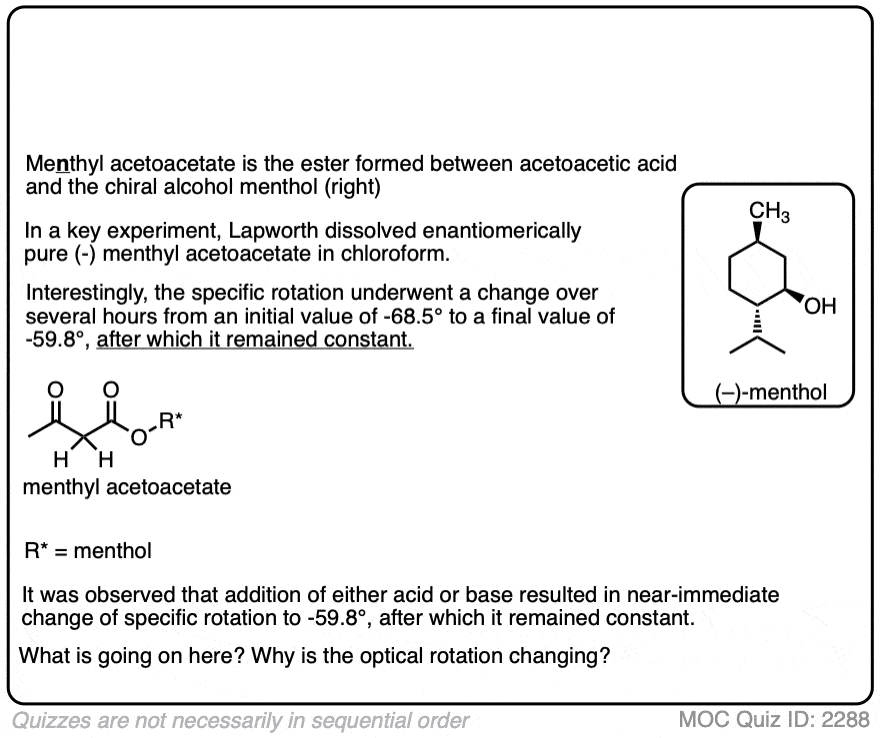 Click to Flip
Click to Flip
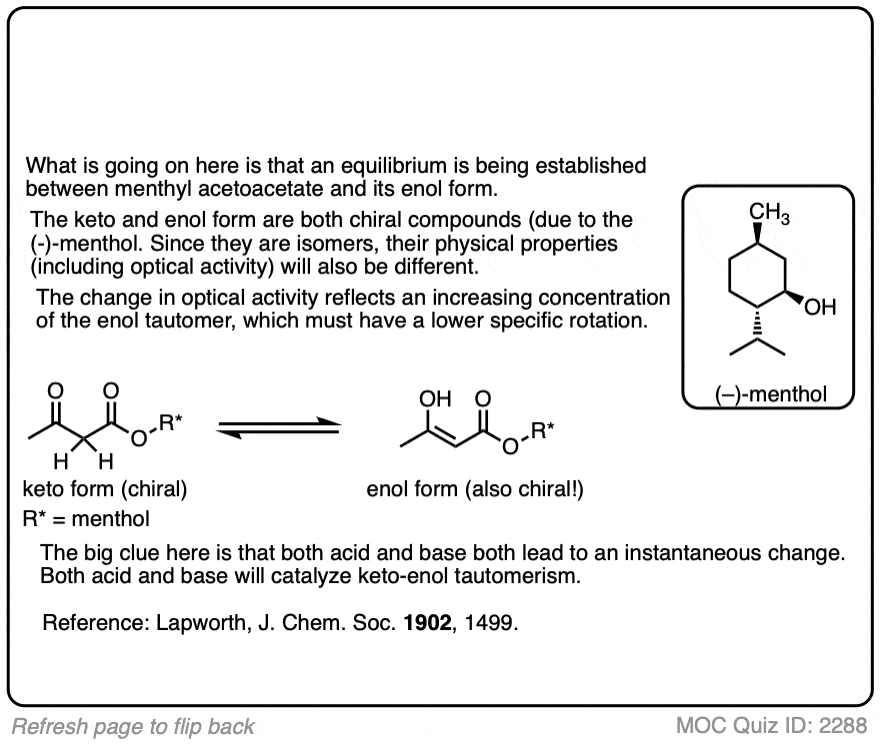
00 General Chemistry Review
01 Bonding, Structure, and Resonance
- How Do We Know Methane (CH4) Is Tetrahedral?
- Hybrid Orbitals and Hybridization
- How To Determine Hybridization: A Shortcut
- Orbital Hybridization And Bond Strengths
- Sigma bonds come in six varieties: Pi bonds come in one
- A Key Skill: How to Calculate Formal Charge
- The Four Intermolecular Forces and How They Affect Boiling Points
- 3 Trends That Affect Boiling Points
- How To Use Electronegativity To Determine Electron Density (and why NOT to trust formal charge)
- Introduction to Resonance
- How To Use Curved Arrows To Interchange Resonance Forms
- Evaluating Resonance Forms (1) - The Rule of Least Charges
- How To Find The Best Resonance Structure By Applying Electronegativity
- Evaluating Resonance Structures With Negative Charges
- Evaluating Resonance Structures With Positive Charge
- Exploring Resonance: Pi-Donation
- Exploring Resonance: Pi-acceptors
- In Summary: Evaluating Resonance Structures
- Drawing Resonance Structures: 3 Common Mistakes To Avoid
- How to apply electronegativity and resonance to understand reactivity
- Bond Hybridization Practice
- Structure and Bonding Practice Quizzes
- Resonance Structures Practice
02 Acid Base Reactions
- Introduction to Acid-Base Reactions
- Acid Base Reactions In Organic Chemistry
- The Stronger The Acid, The Weaker The Conjugate Base
- Walkthrough of Acid-Base Reactions (3) - Acidity Trends
- Five Key Factors That Influence Acidity
- Acid-Base Reactions: Introducing Ka and pKa
- How to Use a pKa Table
- The pKa Table Is Your Friend
- A Handy Rule of Thumb for Acid-Base Reactions
- Acid Base Reactions Are Fast
- pKa Values Span 60 Orders Of Magnitude
- How Protonation and Deprotonation Affect Reactivity
- Acid Base Practice Problems
03 Alkanes and Nomenclature
- Meet the (Most Important) Functional Groups
- Condensed Formulas: Deciphering What the Brackets Mean
- Hidden Hydrogens, Hidden Lone Pairs, Hidden Counterions
- Don't Be Futyl, Learn The Butyls
- Primary, Secondary, Tertiary, Quaternary In Organic Chemistry
- Branching, and Its Affect On Melting and Boiling Points
- The Many, Many Ways of Drawing Butane
- Wedge And Dash Convention For Tetrahedral Carbon
- Common Mistakes in Organic Chemistry: Pentavalent Carbon
- Table of Functional Group Priorities for Nomenclature
- Summary Sheet - Alkane Nomenclature
- Organic Chemistry IUPAC Nomenclature Demystified With A Simple Puzzle Piece Approach
- Boiling Point Quizzes
- Organic Chemistry Nomenclature Quizzes
04 Conformations and Cycloalkanes
- Staggered vs Eclipsed Conformations of Ethane
- Conformational Isomers of Propane
- Newman Projection of Butane (and Gauche Conformation)
- Introduction to Cycloalkanes
- Geometric Isomers In Small Rings: Cis And Trans Cycloalkanes
- Calculation of Ring Strain In Cycloalkanes
- Cycloalkanes - Ring Strain In Cyclopropane And Cyclobutane
- Cyclohexane Conformations
- Cyclohexane Chair Conformation: An Aerial Tour
- How To Draw The Cyclohexane Chair Conformation
- The Cyclohexane Chair Flip
- The Cyclohexane Chair Flip - Energy Diagram
- Substituted Cyclohexanes - Axial vs Equatorial
- Ranking The Bulkiness Of Substituents On Cyclohexanes: "A-Values"
- Cyclohexane Chair Conformation Stability: Which One Is Lower Energy?
- Fused Rings - Cis-Decalin and Trans-Decalin
- Naming Bicyclic Compounds - Fused, Bridged, and Spiro
- Bredt's Rule (And Summary of Cycloalkanes)
- Newman Projection Practice
- Cycloalkanes Practice Problems
05 A Primer On Organic Reactions
- The Most Important Question To Ask When Learning a New Reaction
- Curved Arrows (for reactions)
- Nucleophiles and Electrophiles
- The Three Classes of Nucleophiles
- Nucleophilicity vs. Basicity
- What Makes A Good Nucleophile?
- What Makes A Good Leaving Group?
- 3 Factors That Stabilize Carbocations
- Equilibrium and Energy Relationships
- 7 Factors that stabilize negative charge in organic chemistry
- 7 Factors That Stabilize Positive Charge in Organic Chemistry
- What's a Transition State?
- Hammond's Postulate
- Learning Organic Chemistry Reactions: A Checklist (PDF)
- Introduction to Oxidative Cleavage Reactions
06 Free Radical Reactions
- Bond Dissociation Energies = Homolytic Cleavage
- Free Radical Reactions
- 3 Factors That Stabilize Free Radicals
- What Factors Destabilize Free Radicals?
- Bond Strengths And Radical Stability
- Free Radical Initiation: Why Is "Light" Or "Heat" Required?
- Initiation, Propagation, Termination
- Monochlorination Products Of Propane, Pentane, And Other Alkanes
- Selectivity In Free Radical Reactions
- Selectivity in Free Radical Reactions: Bromination vs. Chlorination
- Halogenation At Tiffany's
- Allylic Bromination
- Bonus Topic: Allylic Rearrangements
- In Summary: Free Radicals
- Synthesis (2) - Reactions of Alkanes
- Free Radicals Practice Quizzes
07 Stereochemistry and Chirality
- Types of Isomers: Constitutional Isomers, Stereoisomers, Enantiomers, and Diastereomers
- How To Draw The Enantiomer Of A Chiral Molecule
- How To Draw A Bond Rotation
- Introduction to Assigning (R) and (S): The Cahn-Ingold-Prelog Rules
- Assigning Cahn-Ingold-Prelog (CIP) Priorities (2) - The Method of Dots
- Enantiomers vs Diastereomers vs The Same? Two Methods For Solving Problems
- Assigning R/S To Newman Projections (And Converting Newman To Line Diagrams)
- How To Determine R and S Configurations On A Fischer Projection
- The Meso Trap
- Optical Rotation, Optical Activity, and Specific Rotation
- Optical Purity and Enantiomeric Excess
- What's a Racemic Mixture?
- Chiral Allenes And Chiral Axes
- Stereochemistry Practice Problems and Quizzes
08 Substitution Reactions
- Nucleophilic Substitution Reactions - Introduction
- Two Types of Nucleophilic Substitution Reactions
- The SN2 Mechanism
- Why the SN2 Reaction Is Powerful
- The SN1 Mechanism
- The Conjugate Acid Is A Better Leaving Group
- Comparing the SN1 and SN2 Reactions
- Polar Protic? Polar Aprotic? Nonpolar? All About Solvents
- Steric Hindrance is Like a Fat Goalie
- Common Blind Spot: Intramolecular Reactions
- Substitution Practice - SN1
- Substitution Practice - SN2
09 Elimination Reactions
- Elimination Reactions (1): Introduction And The Key Pattern
- Elimination Reactions (2): The Zaitsev Rule
- Elimination Reactions Are Favored By Heat
- Two Elimination Reaction Patterns
- The E1 Reaction
- The E2 Mechanism
- E1 vs E2: Comparing the E1 and E2 Reactions
- Antiperiplanar Relationships: The E2 Reaction and Cyclohexane Rings
- Bulky Bases in Elimination Reactions
- Comparing the E1 vs SN1 Reactions
- Elimination (E1) Reactions With Rearrangements
- E1cB - Elimination (Unimolecular) Conjugate Base
- Elimination (E1) Practice Problems And Solutions
- Elimination (E2) Practice Problems and Solutions
10 Rearrangements
11 SN1/SN2/E1/E2 Decision
- Identifying Where Substitution and Elimination Reactions Happen
- Deciding SN1/SN2/E1/E2 (1) - The Substrate
- Deciding SN1/SN2/E1/E2 (2) - The Nucleophile/Base
- SN1 vs E1 and SN2 vs E2 : The Temperature
- Deciding SN1/SN2/E1/E2 - The Solvent
- Wrapup: The Key Factors For Determining SN1/SN2/E1/E2
- Alkyl Halide Reaction Map And Summary
- SN1 SN2 E1 E2 Practice Problems
12 Alkene Reactions
- E and Z Notation For Alkenes (+ Cis/Trans)
- Alkene Stability
- Alkene Addition Reactions: "Regioselectivity" and "Stereoselectivity" (Syn/Anti)
- Stereoselective and Stereospecific Reactions
- Hydrohalogenation of Alkenes and Markovnikov's Rule
- Hydration of Alkenes With Aqueous Acid
- Rearrangements in Alkene Addition Reactions
- Halogenation of Alkenes and Halohydrin Formation
- Oxymercuration Demercuration of Alkenes
- Hydroboration Oxidation of Alkenes
- m-CPBA (meta-chloroperoxybenzoic acid)
- OsO4 (Osmium Tetroxide) for Dihydroxylation of Alkenes
- Palladium on Carbon (Pd/C) for Catalytic Hydrogenation of Alkenes
- Cyclopropanation of Alkenes
- A Fourth Alkene Addition Pattern - Free Radical Addition
- Alkene Reactions: Ozonolysis
- Summary: Three Key Families Of Alkene Reaction Mechanisms
- Synthesis (4) - Alkene Reaction Map, Including Alkyl Halide Reactions
- Alkene Reactions Practice Problems
13 Alkyne Reactions
- Acetylides from Alkynes, And Substitution Reactions of Acetylides
- Partial Reduction of Alkynes With Lindlar's Catalyst
- Partial Reduction of Alkynes With Na/NH3 To Obtain Trans Alkenes
- Alkyne Hydroboration With "R2BH"
- Hydration and Oxymercuration of Alkynes
- Hydrohalogenation of Alkynes
- Alkyne Halogenation: Bromination, Chlorination, and Iodination of Alkynes
- Alkyne Reactions - The "Concerted" Pathway
- Alkenes To Alkynes Via Halogenation And Elimination Reactions
- Alkynes Are A Blank Canvas
- Synthesis (5) - Reactions of Alkynes
- Alkyne Reactions Practice Problems With Answers
14 Alcohols, Epoxides and Ethers
- Alcohols - Nomenclature and Properties
- Alcohols Can Act As Acids Or Bases (And Why It Matters)
- Alcohols - Acidity and Basicity
- The Williamson Ether Synthesis
- Ethers From Alkenes, Tertiary Alkyl Halides and Alkoxymercuration
- Alcohols To Ethers via Acid Catalysis
- Cleavage Of Ethers With Acid
- Epoxides - The Outlier Of The Ether Family
- Opening of Epoxides With Acid
- Epoxide Ring Opening With Base
- Making Alkyl Halides From Alcohols
- Tosylates And Mesylates
- PBr3 and SOCl2
- Elimination Reactions of Alcohols
- Elimination of Alcohols To Alkenes With POCl3
- Alcohol Oxidation: "Strong" and "Weak" Oxidants
- Demystifying The Mechanisms of Alcohol Oxidations
- Protecting Groups For Alcohols
- Thiols And Thioethers
- Calculating the oxidation state of a carbon
- Oxidation and Reduction in Organic Chemistry
- Oxidation Ladders
- SOCl2 Mechanism For Alcohols To Alkyl Halides: SN2 versus SNi
- Alcohol Reactions Roadmap (PDF)
- Alcohol Reaction Practice Problems
- Epoxide Reaction Quizzes
- Oxidation and Reduction Practice Quizzes
15 Organometallics
- What's An Organometallic?
- Formation of Grignard and Organolithium Reagents
- Organometallics Are Strong Bases
- Reactions of Grignard Reagents
- Protecting Groups In Grignard Reactions
- Synthesis Problems Involving Grignard Reagents
- Grignard Reactions And Synthesis (2)
- Organocuprates (Gilman Reagents): How They're Made
- Gilman Reagents (Organocuprates): What They're Used For
- The Heck, Suzuki, and Olefin Metathesis Reactions (And Why They Don't Belong In Most Introductory Organic Chemistry Courses)
- Reaction Map: Reactions of Organometallics
- Grignard Practice Problems
16 Spectroscopy
- Degrees of Unsaturation (or IHD, Index of Hydrogen Deficiency)
- Conjugation And Color (+ How Bleach Works)
- Introduction To UV-Vis Spectroscopy
- UV-Vis Spectroscopy: Absorbance of Carbonyls
- UV-Vis Spectroscopy: Practice Questions
- Bond Vibrations, Infrared Spectroscopy, and the "Ball and Spring" Model
- Infrared Spectroscopy: A Quick Primer On Interpreting Spectra
- IR Spectroscopy: 4 Practice Problems
- 1H NMR: How Many Signals?
- Homotopic, Enantiotopic, Diastereotopic
- Diastereotopic Protons in 1H NMR Spectroscopy: Examples
- 13-C NMR - How Many Signals
- Liquid Gold: Pheromones In Doe Urine
- Natural Product Isolation (1) - Extraction
- Natural Product Isolation (2) - Purification Techniques, An Overview
- Structure Determination Case Study: Deer Tarsal Gland Pheromone
17 Dienes and MO Theory
- What To Expect In Organic Chemistry 2
- Are these molecules conjugated?
- Conjugation And Resonance In Organic Chemistry
- Bonding And Antibonding Pi Orbitals
- Molecular Orbitals of The Allyl Cation, Allyl Radical, and Allyl Anion
- Pi Molecular Orbitals of Butadiene
- Reactions of Dienes: 1,2 and 1,4 Addition
- Thermodynamic and Kinetic Products
- More On 1,2 and 1,4 Additions To Dienes
- s-cis and s-trans
- The Diels-Alder Reaction
- Cyclic Dienes and Dienophiles in the Diels-Alder Reaction
- Stereochemistry of the Diels-Alder Reaction
- Exo vs Endo Products In The Diels Alder: How To Tell Them Apart
- HOMO and LUMO In the Diels Alder Reaction
- Why Are Endo vs Exo Products Favored in the Diels-Alder Reaction?
- Diels-Alder Reaction: Kinetic and Thermodynamic Control
- The Retro Diels-Alder Reaction
- The Intramolecular Diels Alder Reaction
- Regiochemistry In The Diels-Alder Reaction
- The Cope and Claisen Rearrangements
- Electrocyclic Reactions
- Electrocyclic Ring Opening And Closure (2) - Six (or Eight) Pi Electrons
- Diels Alder Practice Problems
- Molecular Orbital Theory Practice
18 Aromaticity
- Introduction To Aromaticity
- Rules For Aromaticity
- Huckel's Rule: What Does 4n+2 Mean?
- Aromatic, Non-Aromatic, or Antiaromatic? Some Practice Problems
- Antiaromatic Compounds and Antiaromaticity
- The Pi Molecular Orbitals of Benzene
- The Pi Molecular Orbitals of Cyclobutadiene
- Frost Circles
- Aromaticity Practice Quizzes
19 Reactions of Aromatic Molecules
- Electrophilic Aromatic Substitution: Introduction
- Activating and Deactivating Groups In Electrophilic Aromatic Substitution
- Electrophilic Aromatic Substitution - The Mechanism
- Ortho-, Para- and Meta- Directors in Electrophilic Aromatic Substitution
- Understanding Ortho, Para, and Meta Directors
- Why are halogens ortho- para- directors?
- Disubstituted Benzenes: The Strongest Electron-Donor "Wins"
- Electrophilic Aromatic Substitutions (1) - Halogenation of Benzene
- Electrophilic Aromatic Substitutions (2) - Nitration and Sulfonation
- EAS Reactions (3) - Friedel-Crafts Acylation and Friedel-Crafts Alkylation
- Intramolecular Friedel-Crafts Reactions
- Nucleophilic Aromatic Substitution (NAS)
- Nucleophilic Aromatic Substitution (2) - The Benzyne Mechanism
- Reactions on the "Benzylic" Carbon: Bromination And Oxidation
- The Wolff-Kishner, Clemmensen, And Other Carbonyl Reductions
- More Reactions on the Aromatic Sidechain: Reduction of Nitro Groups and the Baeyer Villiger
- Aromatic Synthesis (1) - "Order Of Operations"
- Synthesis of Benzene Derivatives (2) - Polarity Reversal
- Aromatic Synthesis (3) - Sulfonyl Blocking Groups
- Birch Reduction
- Synthesis (7): Reaction Map of Benzene and Related Aromatic Compounds
- Aromatic Reactions and Synthesis Practice
- Electrophilic Aromatic Substitution Practice Problems
20 Aldehydes and Ketones
- What's The Alpha Carbon In Carbonyl Compounds?
- Nucleophilic Addition To Carbonyls
- Aldehydes and Ketones: 14 Reactions With The Same Mechanism
- Sodium Borohydride (NaBH4) Reduction of Aldehydes and Ketones
- Grignard Reagents For Addition To Aldehydes and Ketones
- Wittig Reaction
- Hydrates, Hemiacetals, and Acetals
- Imines - Properties, Formation, Reactions, and Mechanisms
- All About Enamines
- Breaking Down Carbonyl Reaction Mechanisms: Reactions of Anionic Nucleophiles (Part 2)
- Aldehydes Ketones Reaction Practice
21 Carboxylic Acid Derivatives
- Nucleophilic Acyl Substitution (With Negatively Charged Nucleophiles)
- Addition-Elimination Mechanisms With Neutral Nucleophiles (Including Acid Catalysis)
- Basic Hydrolysis of Esters - Saponification
- Transesterification
- Proton Transfer
- Fischer Esterification - Carboxylic Acid to Ester Under Acidic Conditions
- Lithium Aluminum Hydride (LiAlH4) For Reduction of Carboxylic Acid Derivatives
- LiAlH[Ot-Bu]3 For The Reduction of Acid Halides To Aldehydes
- Di-isobutyl Aluminum Hydride (DIBAL) For The Partial Reduction of Esters and Nitriles
- Amide Hydrolysis
- Thionyl Chloride (SOCl2)
- Diazomethane (CH2N2)
- Carbonyl Chemistry: Learn Six Mechanisms For the Price Of One
- Making Music With Mechanisms (PADPED)
- Carboxylic Acid Derivatives Practice Questions
22 Enols and Enolates
- Keto-Enol Tautomerism
- Enolates - Formation, Stability, and Simple Reactions
- Kinetic Versus Thermodynamic Enolates
- Aldol Addition and Condensation Reactions
- Reactions of Enols - Acid-Catalyzed Aldol, Halogenation, and Mannich Reactions
- Claisen Condensation and Dieckmann Condensation
- Decarboxylation
- The Malonic Ester and Acetoacetic Ester Synthesis
- The Michael Addition Reaction and Conjugate Addition
- The Robinson Annulation
- Haloform Reaction
- The Hell–Volhard–Zelinsky Reaction
- Enols and Enolates Practice Quizzes
23 Amines
- The Amide Functional Group: Properties, Synthesis, and Nomenclature
- Basicity of Amines And pKaH
- 5 Key Basicity Trends of Amines
- The Mesomeric Effect And Aromatic Amines
- Nucleophilicity of Amines
- Alkylation of Amines (Sucks!)
- Reductive Amination
- The Gabriel Synthesis
- Some Reactions of Azides
- The Hofmann Elimination
- The Hofmann and Curtius Rearrangements
- The Cope Elimination
- Protecting Groups for Amines - Carbamates
- The Strecker Synthesis of Amino Acids
- Introduction to Peptide Synthesis
- Reactions of Diazonium Salts: Sandmeyer and Related Reactions
- Amine Practice Questions
24 Carbohydrates
- D and L Notation For Sugars
- Pyranoses and Furanoses: Ring-Chain Tautomerism In Sugars
- What is Mutarotation?
- Reducing Sugars
- The Big Damn Post Of Carbohydrate-Related Chemistry Definitions
- The Haworth Projection
- Converting a Fischer Projection To A Haworth (And Vice Versa)
- Reactions of Sugars: Glycosylation and Protection
- The Ruff Degradation and Kiliani-Fischer Synthesis
- Isoelectric Points of Amino Acids (and How To Calculate Them)
- Carbohydrates Practice
- Amino Acid Quizzes
25 Fun and Miscellaneous
- A Gallery of Some Interesting Molecules From Nature
- Screw Organic Chemistry, I'm Just Going To Write About Cats
- On Cats, Part 1: Conformations and Configurations
- On Cats, Part 2: Cat Line Diagrams
- On Cats, Part 4: Enantiocats
- On Cats, Part 6: Stereocenters
- Organic Chemistry Is Shit
- The Organic Chemistry Behind "The Pill"
- Maybe they should call them, "Formal Wins" ?
- Why Do Organic Chemists Use Kilocalories?
- The Principle of Least Effort
- Organic Chemistry GIFS - Resonance Forms
- Reproducibility In Organic Chemistry
- What Holds The Nucleus Together?
- How Reactions Are Like Music
- Organic Chemistry and the New MCAT
26 Organic Chemistry Tips and Tricks
- Common Mistakes: Formal Charges Can Mislead
- Partial Charges Give Clues About Electron Flow
- Draw The Ugly Version First
- Organic Chemistry Study Tips: Learn the Trends
- The 8 Types of Arrows In Organic Chemistry, Explained
- Top 10 Skills To Master Before An Organic Chemistry 2 Final
- Common Mistakes with Carbonyls: Carboxylic Acids... Are Acids!
- Planning Organic Synthesis With "Reaction Maps"
- Alkene Addition Pattern #1: The "Carbocation Pathway"
- Alkene Addition Pattern #2: The "Three-Membered Ring" Pathway
- Alkene Addition Pattern #3: The "Concerted" Pathway
- Number Your Carbons!
- The 4 Major Classes of Reactions in Org 1
- How (and why) electrons flow
- Grossman's Rule
- Three Exam Tips
- A 3-Step Method For Thinking Through Synthesis Problems
- Putting It Together
- Putting Diels-Alder Products in Perspective
- The Ups and Downs of Cyclohexanes
- The Most Annoying Exceptions in Org 1 (Part 1)
- The Most Annoying Exceptions in Org 1 (Part 2)
- The Marriage May Be Bad, But the Divorce Still Costs Money
- 9 Nomenclature Conventions To Know
- Nucleophile attacks Electrophile
27 Case Studies of Successful O-Chem Students
- Success Stories: How Corina Got The The "Hard" Professor - And Got An A+ Anyway
- How Helena Aced Organic Chemistry
- From a "Drop" To B+ in Org 2 – How A Hard Working Student Turned It Around
- How Serge Aced Organic Chemistry
- Success Stories: How Zach Aced Organic Chemistry 1
- Success Stories: How Kari Went From C– to B+
- How Esther Bounced Back From a "C" To Get A's In Organic Chemistry 1 And 2
- How Tyrell Got The Highest Grade In Her Organic Chemistry Course
- This Is Why Students Use Flashcards
- Success Stories: How Stu Aced Organic Chemistry
- How John Pulled Up His Organic Chemistry Exam Grades
- Success Stories: How Nathan Aced Organic Chemistry (Without It Taking Over His Life)
- How Chris Aced Org 1 and Org 2
- Interview: How Jay Got an A+ In Organic Chemistry
- How to Do Well in Organic Chemistry: One Student's Advice
- "America's Top TA" Shares His Secrets For Teaching O-Chem
- "Organic Chemistry Is Like..." - A Few Metaphors
- How To Do Well In Organic Chemistry: Advice From A Tutor
- Guest post: "I went from being afraid of tests to actually looking forward to them".
Plzz discuss the mechanism when rate of mutarotation islow in D2o than in H20 .
Thanks James. What do they do for structural carbohydrates that are insoluble?
If it’s not soluble, I don’t know how useful the technique of mutarotation will be. Usually I would think that they would digest it with acid or similar to bread down the polysaccharide into smaller, more soluble chunks.
How quickly does the mutarotation occur? If I isolated a natural sugar from a mixture and wanted to test how much is alpha vs. beta, how fast would that have to happen?
hi Tanya. Several hours. However, it’s going to be solvent-dependent (more polar = faster) and also sensitive to the presence of acids and bases (which will speed it up). The original observation took several hours for the optical rotation to change.
These days most people would just put it in an NMR spectrometer and observe it that way.
Thank you very much😉😉😉
will the mutarotation of an impure glucose solution be the same as that of pure?
Why would you expect them to be the same if one is pure and one is impure?
Does impurity affect the mutarotation of glucose, are the results for a pure and impure glucose be different after mutarotation
Yes, impurities could dramatically affect the mutarotation of glucose. The rotation values given are for pure compounds, for which an accurate calculation of concentration can be made. If the sample is impure (and especially if it is contaminated with an optically active impurity) the measured number will be way off.
Really appreciate the article! Where can I find the methods for synthesizing and isolating the alpha and beta anomers of D-glucose? (If possible, a method attainable in a high-school lab would be much appreciated.)
Maybe this J. Chem. Ed. paper?
https://pubs.acs.org/doi/10.1021/ed086p959
Why is there a higher proportion of beta anomers than alpha at equilibrium?
Mutarotation in monosaccharides is best represented by the interconversion of D vs.L isomers
No!!!!
in glucose molecule and alpha and beta d glucose angle change during mutarotation,In the sense when glucose molecule has 52.5 degree,when it convert alpha D(+) glucoe it changes about 111 degree .What is the reason behind this?
Awaiting for your revert on my email id
thanks and reply get instantly
Best regards
It is actually the interconversion b.w the 2 anomeric forms(a AND B) of glucose in a solution,so that the optical activity of such solution is that of an equillibrium solution ie 52.5′
Wouldn’t mutarotation require a catalyst? In the typical mechanism for hemiacetal/hemiketal formation we use an acid catalyst. Why would mutarotation be able to occur spontaneously in water?
It would be faster in the presence of acid, but mutarotation occurs in the absence of a catalyst. Hemiacetal formation is reversible. The original experiments from the 1800’s when this phenomenon were discovered were all in water.
Thank you!
I have wondered about this. Why does a hemi-acetal open under neutral pH but a full acetal requires acid to open?
I assume it must be a hydrogen bond between water lone pairs and the hydrogen on the hydroxyl of the hemi-acetal. This would weaken the OH bond and facilitate ring opening.
This seems like an example of “general base” catalysis, where a deprotonation is concerted with the ring opening. Though I am not sure if this applies when it is the solvent doing the catalysis.
Here’s one way to draw the mechanism of mutarotation. https://www.masterorganicchemistry.com/wp-content/uploads/2017/08/4-mechanism-1-e1560893258548.png
I think the alpha and beta explanation is a bit conflicting between the text and the scheme.
Fixed! Thank you.